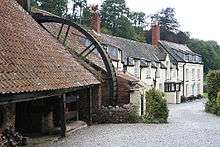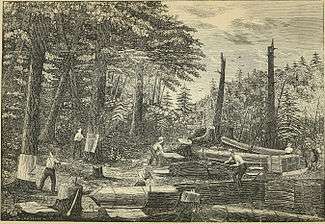Bark mill

Bark mills were used to grinding or cutting the roots, branches, or barks of different species of trees, to form a fine powder (tanbark) suitable for the operations of the tanner in the preparation of leather for clothes, boots, furniture, etc. The powdered wood more quickly yields up the tannin required for the tanning process.[1] The dried bark was often stored in bark houses.
Water-, steam-, horse- or ox- and wind-powered bark mills existed.[2] Water-powered bark mills were sitting alongside rivers and leats were dug to bring water to the wheel.
A barker was a person who stripped bark from trees to supply bark mills.[3]
Bark mill machinery
Various forms of machinery were used in the process of chopping, grinding, riddling and pounding the bark, such as Farcot’s bark-cutting machine, extensively used in France, Weldon’s bark-grinding mill, and another grinding mill, much used in America and known as Wiltze’s or Catskill’s mill.[1]
Tanning

Bark or vegetable tanning
Bark tanning or vegetable tanning is part of the ancient process of creating durable, water repellent leather with a lot of 'body'. It can be done to most types of skin, but it is usually reserved for tanning leathers from large and thick hides such as cattle, horses, and pigs. The leather produced has been commonly used for saddles, canteens, stiff shoes, belts, wallets, holsters, harnesses, helmets, pouches, trunks, shields and gun cases. It was also used as an integral part of bellows, hinges, wagon wheels, etc.[4] Vegetable tanned hide is flexible and is used for luggage and furniture.
Mineral tanning
Mineral tanning, being cheaper and faster, replaced the use of bark and mainly uses chromium Sulphate. Once the desired level of penetration of chrome into the substance is achieved, the pH of the material is raised again to facilitate the process. In the raw state chrome tanned skins are blue. Chrome tanning produces a stretchable leather which is excellent for use in handbags and garments.
Tawing uses alum and aluminium salts, together with egg yolk, flour, and other salts. The leather becomes 'tawed' by soaking in a warm potash alum and salts solution. The process increases the pliability, stretchability, softness, and quality of the leather. The addition of egg yolk and flour to the standard soaking solution further enhances its fine handling characteristics. Then, the leather is air dried for several weeks, which allows it to stabilize. Tawing is used on pigskins and goatskins to create the whitest colour.
Examples of Bark Mills
- Bampton Bark Mill, in Bampton, Devon, England[5]
- Beith Bark Mill, in Beith, North Ayrshire, Scotland - On the east bank of Kilbirnie Loch near Beith in North Ayrshire stood a Bark Mill, most built by the Muir's of Mains House. It is marked on OS maps, and was powered by the combined Mains and Bath Burns with mill ponds indicated. The mill produced ground bark for use in the Beith Bath Lane tannery, using bark from the old oak trees that forested the loch side. Later the mill became a furniture factory run by Matthew Pollock who applied the use of machinery to help with the manufacture of furniture in 1858. This site was one mile from the Beith town centre. The Glasgow & South Western Railway Company constructed a siding, known as 'Muir's siding' for the convenience of transporting the finished products, etc. The site was isolated and inconvenient for the workers and was eventually sold to Robert Balfour, who later built a new factory near Beith Town Station, the West of Scotland Cabinet Works. The Muirs had been tanners for many generations and around 1791 John Muir and Sons, Tanners, Curriers, and Fancy Leather Manufacturers had become established at the Bath Lane works. William Muir of Mains joined as a partner in 1846.
- Mill on the Fleet, in Gatehouse of Fleet, Castle Douglas, Scotland - Built in 1788 as a cotton spinning mill by James Birtwhistle from Yorkshire. The water wheel on the gable end was used to drive the machinery to spin the cotton. By 1800 the cotton industry in Gatehouse declined and by 1850 the mills were out of use. In 1859 they were bought by the Helme brothers from Dalbeattie and the mill was used as a store and bark mill.[6]
- Terling Windmill, in Terling, Essex - a grade II listed Smock mill. The mill was originally a bark mill, but was advertised for sale in 1818 as “new built”, easily convertible to corn grinding.[7]
- Heigham, Norwich - A tannery in Heigham, Norwich, Norfolk was advertised for sale in 1853. It was again advertised for sale and removal in 1863. It may have been moved to a new site and converted to a drainage mill.[8]
References
Notes;
- 1 2 Muspratt Bark Mill Retrieved : 2011-02-03
- ↑ Bark Mills Retrieved : 2011-02-03
- ↑ Barkers Retrieved : 2011-02-03
- ↑ Ambleside Sheepskins Archived September 3, 2011, at the Wayback Machine. Retrieved : 2011-02-03
- ↑ Bampton Mill Archived May 22, 2011, at the Wayback Machine. Retrieved : 2011-02-03
- ↑ Mill on the Fleet Retrieved : 2011-02-03
- ↑ Farries, Kenneth (1988). Essex Windmills, Millers and Millwrights - Volume Five- A Review by Parishes, S-Z. Weston-Super-Mare: Charles Skilton. pp. 45–46. ISBN 0-284-98821-9.
- ↑ Roots, Michael. "Heigham - bark smockmill". Norfolk Mills. Retrieved 1 October 2014.
External links
| Wikimedia Commons has media related to Bark Mill. |